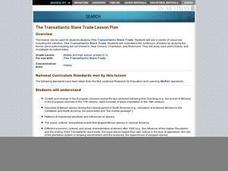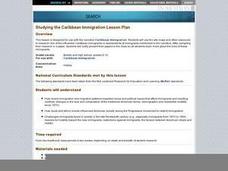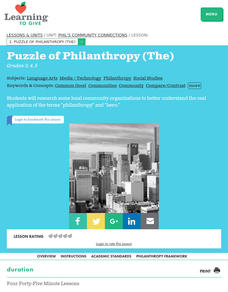Curated OER
Technology: Rating Inventions
Third graders brainstorm a list of inventions used daily. They use Kidspiration to create a web with inventions in the middle. Students choose three inventions from the web and rank them according to interest.
Curated OER
Diverse Voices - African American Ventures
Students research African American history and the Underground Railroad. In this African American history lesson, students discuss the Drinking Gourd. Students read 'If You Traveled the Underground Railroad' and discuss. Students work in...
Curated OER
Indians of the Woodlands
Students read and discuss a text about housing styles of the Haida and Iroquois Indians. They, in groups, complete worksheets and present their findings to the class.
Curated OER
Zhou Dynasty
Pupils research the contributions of the Zho Dynasty. They identify the Mandate of Heaven, and the growth of the economy under the Zhou. They research the history of the discovery of silk and its role as an export. Finally, they...
Curated OER
Mobius Band
Tenth graders discuss sides of a shape and how to collect data correctly. In this geometry lesson, 10th graders examine shapes and count the surfaces on the shape. They read the history of Mobius Band and relate it to surface area.
Curated OER
The Berlin Wall
Middle schoolers enter the classroom and observe a wall that is set up with desks, bookshelves, or anything else available. to create a barrier that they cannot cross during the class. The class then is divided into East and West Berlin...
Curated OER
What Does a Nonprofit Do, and for Whom?
Students investigate key local and national nonprofit organizations by researching their histories, services, and target populations. Student pairs present their information to the rest of the class. Each student will be responsible for...
Curated OER
Changing for the Common Good
Students examine the nonprofit sector and how it has made positive changes in society. They create a timeline noting events related to disadvantaged groups. They work together to research the events.
Curated OER
3-D Posters
Students work in small groups to create 3-D posters to discourage throwing trash away and encourage recycling.
Curated OER
The Mayflower Compact
Students use primary source documents to discuss the Mayflower Compact and the story of the first Thanksgiving. They discover how the Pilgrims were influenced in developing a community and American democracy.
Curated OER
The Transatlantic Slave Trade Lesson Plan
Students study former slave ports in the South.
Curated OER
Studying the Caribbean Immigration
Students use the site maps and other resources to research one of the influential Caribbean immigrants or descendents of immigrants mentioned in a narrative they have read. They write an essay about an influential immigrant.
Curated OER
Haitian Immigration: Twentieth Century
High schoolers read a narrative about the culture, heritage and history of Haiti including the contributions of Haitian immigrants in the U.S. They conduct further research on Haitian culture and prepare a presentation for the class.
Curated OER
The Study of the Spanish-Speaking People of Texas: Understanding Primary Sources
Young scholars analyze Russell Lee's photo essay as a sign of segregation in Texas. They consider the differences between primary and secondary sources and how historians use these sources.
Curated OER
Don't Let Your Rights Be Violated
Ninth graders engage in a study of the First Amendment of The Constitution. They read the amendment and use a highlighter to note the important parts. Then students journal the connections of its importance to daily life. They include...
Curated OER
Omaha's Whose Who at Prospect Hill Cemetery
Students explore and are able to explain how to read an old street map of downtown Omaha. Students review the names of schools in OPS as well as country names in Nebraska. They find out the names of graves in Prospect Hill Cemetery....
Curated OER
Tribal Termination & Urbanization
Pupils list the main events in historical sequence of tribal termination and urbanization. They identify a present-day American Indian experience or phenomenon as a result of termination and urbanization and refer to 'Navajo...
Curated OER
The Four Sacred Elements
Fourth graders observe the Four Sacred Elements image in PowerPoint as projected on a screen and discuss what they see and then summarize the details. They discuss what the image represents and how the Four Sacred Elements are an...
Curated OER
Why Should We Clean The Beach?
Young scholars volunteer for the International Coastal Cleanup. They describe the purpose of the Lake Michigan Foundation and a history of the dunes. They reflect on their experiences with writing.
Curated OER
Dividing the Philanthropic Shares
Students define who volunteers are the and the types of jobs that they do. They identify various groups who volunteer in their community, and locate them on a city map.
Curated OER
The Mayflower Compact Started It
Pupils examine the role the Mayflower Compact had in aiding the common good. They analyze the importance of the Compact and what affect it had on the colony. They write a paper summarizing how they interpreted the Compact itself.
Curated OER
The Puzzle of Philanthropy
Students research community organizations in their area. They identify three acts of philanthropy and three resources in the community that could help the common good. They reflect on their research in journal writings.
Curated OER
Mary Eliza Church Terrell -- Civil Rights Leader
Students examine writings of Mary Eliza Church Terrell. They role play themselves as an African American woman in the 19th century. They describe her actions and how they benefited minorities.
Curated OER
The Western Migration Lesson Plan: Socratic Seminar
Learners participate in a Socratic Seminar and explore Western Migration.

























